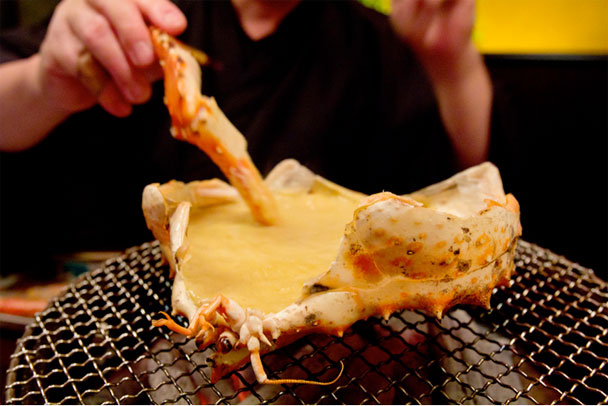My wife and I were traveling to Sendai, a medium sized city on Japan’s eastern Pacific coast, to learn about umami, the fifth flavor sense best described as savory. And according to our host, Jihei Isawa, you can’t learn about umami unless you understand sake and rice.
He should know. His family started making sake for Sendai’s founder Lord Date Masamune more than 300 years ago. They’re still making it today. In fact, our first stop with Isawa was to Masamune’s tomb to pay respects to the old warrior and “connect with the spirits.”
According to Isawa, Masamune was a fairly avant-garde samurai, who killed lots of people (that’s what samurai do), but also had a love of cooking and fine European wines. He sent emissaries to Rome and Spain, a rarity for Japanese leaders at the time. And, as Isawa tells it, he not only jumped into the kitchen, he wrote his food and sake adventures down. Today, he’d probably be a food blogger, albeit one that could cut you in half.
Like Masamune’s emissaries, Isawa has travelled the world. He used to own restaurants in Paris and Florence. His family now owns two restaurants in Sendai, a 400-student cooking school and the sake brewery Katsuyama.
Isawa also has a special relationship with America. The allies bombed his family’s house during WWII, but a general had taken up residence there so his family survived.
As Isawa showed us around his sleek modern brewery in a white lab coat, it was clear there were no hard feelings about the USA, except for one. “I was shocked when I went to America and saw people dumping soy sauce on their rice,” he told me.
Throughout my travels in Japan, this cultural soy sauce divide kept following me. In short, you can do almost anything to rice—fry it, smother it in gelatin, turn it into crackers, cookies or a sticky sweet called mochi. But the one thing you can never do, under pain of expulsion from the dining room, is dump soy sauce on pure white rice. I goofed it plenty of times, but swore not to make that mistake here. And with what Isawa was serving, it was easy.
We lunched at his family’s Japanese restaurant, Shozan-Kan, where we started with an oyster ball in soy milk and bonito broth. Next up was a thinly sliced beef and mushroom rice bowl so packed with flavor I was tempted to flip over the dish to see where they were hiding it all.
Instead I raided the kitchen to see how it was done. Meat and vegetables were flash boiled in a sweet and savory broth in a similar manner to shabu shabu and placed on top of steaming rice. When the dish arrived at the table, we each poured a poached egg on top and mixed it in, and, as in the Korean dish bi bim bop, the heat from the rice partially cooked the egg.
A rice bowl topped with sea eel and shrimp tempura rounded out the feast and got Isawa talking about his twin passions—sake and umami.
Sake, of course, is made from rice, and according to Isawa, that is the key to its uncanny ability to bring out the natural savory, or umami, flavor of foods. Wine, he says, has acid, and that can cut the flavor of food.
“Every type of ingredient, rice can harmonize with it,” he told me. “That’s why sake matches every food, no exceptions.”
It’s a nice saying, especially for a sake brewer. And frankly we were a bit skeptical, but at dinner Isawa put it to the test with something he calls “cooking in the mouth,” essentially swishing a mouthful of sake around your palate and then tasting food.
Here’s how it works.
First we put a little bit of wasabi on a blood red piece of tuna sashimi. We dipped it in soy sauce and enjoyed. The flavors were good and familiar. Next, we poured sake into our soy sauce dish and dropped another piece of tuna into it, in effect marinating the fish. Then we swirled a bit of sake around our mouths, in this case Katsuyama’s Den vintage, and quickly ate the marinating tuna.
An explosion of flavor and then a slow incessant wave of it swept across our palates. It was the natural flavor of the tuna that stayed, not the sake itself. We tried it again with briny sea urchin and the effect was even more pronounced. Then again with octopus sushi, eel, and even pork.
“For umami taste, we need rice to feel it across our entire mouth, across our entire palate. Then the umami flavor explodes,” said Isawa.
The next course was as explosive as it gets—crab brain shabu shabu. Served on a king crab half shell heated over hot coals, the brains were strained then mixed with bonito broth. The pink liquid bubbled and danced as Isawa poured sake into it. He grabbed a fresh crab leg, snapped it open and dipped it into the frothy mixture.
We followed suit and were rewarded with a creamy, briny flavor that tasted of the ocean, blood and salt—almost like sea urchin with the volume cranked up. I loved it. My wife thought I had lost my own brains.
Next, Isawa ordered a round of shot glasses, filling each half with sake and half with crab brains. We shot them down, punch drunk from the umami experience and actually drunk from our third bottle of booze.
Isawa took it easy on us, finishing with a bottle of his Akatsuki sake that had a floral appeal with a long, smooth finish. He matched it with a very traditional Japanese meal closer—miso soup and miso-coated onigiri, essentially a Japanese rice ball.



 Pinterest
Pinterest


